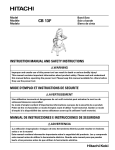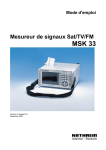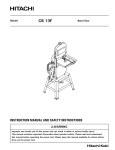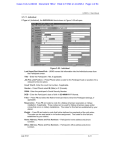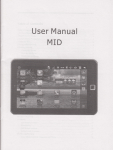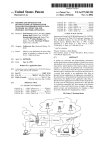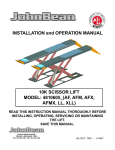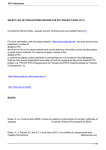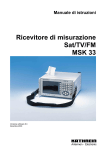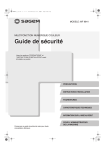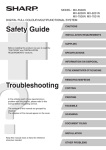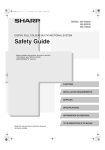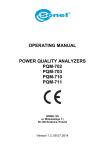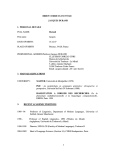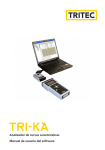Download (12) United States Patent (10) Patent No.: US 8,374,461 B2
Transcript
USOO8374461B2 (12) United States Patent (10) Patent No.: Humphreys et al. (54) (75) (45) Date of Patent: 3,703,272 A 11/1972 Lareau IDENTIFICATION SYSTEM 3,942,016 A 3,962,807 A 4,127,774 A 3/ 1976 SchatZ 6/1976 Pantone 11/1978 Gillen Inventors: Geoffrey Humphreys, Baton Rouge, LA (Us); Chad Lacour, Baton Rouge, LA 4,194,122 A 4,204,639 A (73) Assignee: Smartplates, LLC, Baton Rouge, LA Us) ( _ _ Notlce: _ _ _ Subject to any disclaimer, the term ofthis patent is extended or adjusted under 35 5,179,579 A 1/1993 Dove et a1. 5,195,123 A 6,041,102 A 6,354,737 B1 3/1993 Clement 30000 Francs“ 3/2002 Hufe et al. 6,679,847 B1 * 1/2004 Robinson et al. ........... .. 600/447 7,358,502 B1* 4/2008 Appleby et al. .. 250/37014 7,787,687 B2* Appl' NO; 13/180,886 8/2010 Miyano et al. 382/149 7,987,003 B2 * 2006/0098785 A1 7/2011 Hoffberg et a1. .............. .. 700/17 5/2006 Woods 2008/0084965 A1 4/2008 Ohnona et al. ' (22) 3/1980 Mitchell et al‘ 5/1980 Barber etal. 7,627,370 B2 * 12/2009 Marks ,,,,,,,,,,,,,,,,,,,,, ,, 600/544 U_s_c_ 15403) by 29 days_ (21) Feb. 12, 2013 DIGITAL RADIOGRAPHY PLATE (US) (*) US 8,374,461 B2 FOREIGN PATENT DOCUMENTS Filed: Jul. 12, 2011 (65) EP Prior Publication Data Us 2012/0039520 A1 1 649 812 A1 400% OTHER PUBLICATIONS Feb 16’ 2012 GendeX Dental Systems, “Additional Mount Information”, Imaging Software: ViXWin Platinum User Manual, 2009, pp. 8-4-8-9. Related U_s_ Application Data (60) GendeX Dental Systems, “Accelerated Work?ow”, ViXWin Platinum Brochure, 2000, pp. 5. Provisional application No. 61/363,538, ?led on Jul. 12, 2010. * cited by examiner (51) Int. Cl. Primary Examiner * Yosef Kassa (52) G06K 9/32 (2006-01) U.S. Cl. ...... .. 382/291; 382/128; 382/295; 382/296; 128/922 (74) Attorney, Agent, or Firm * Saliwanchik, Lloyd & Eisenschenk (58) Field of Classi?cation Search ................ .. 382/128, 382/130’ 131: 132’ 291: 295: 296; 128/920: _ _ _ 128/922 see apphcanon ?le for complete searCh hlstOI'Y- ABSTRACT identi?cation, sorting, and positioning of radiographic images. According to one embodiment of the subject inven _ (56) (57) Systems, devices, and methods for facilitating the automatic tion, phosphorous plates for intra-oral imaging are encoded References Clted for automated image set identi?cation, location, and orienta U.S. PATENT DOCUMENTS tion. In certain embodiments, a processing system is able to process encoded identi?ers on the phosphorous plates With 456,396 A 1,358,990 A 1,396,415 A 7/1891 Blakemore 11/1920 Scannell 11/1921 Fried 1,632,154 A 6/1927 Torpin 1,917,433 A 3,619,611 A 7/1933 Cressler 11/1971 Hall digitized images depicted on the phosphorous plates to auto matically identify, sort, and rotate the digitized images into proper orientations for user vieWing. 31 Claims, 6 Drawing Sheets Practice Mgmt. System has a Patient selected and is in 5 Waiting" state where Radiographtc Images are expected for a “To Be Determined" image temptete. Detey and Check iet Receipt of New/ Pending Image or User Request YES trnage set Atteetiy o - em NO US. Patent Feb. 12, 2013 59.5“0QEcBE.o2m3p0?m5Eo 3mi.E@uh3w:62om>c5E3tam»823oua o$31.m2n:vg @Q259235mH.a36n25:.%;3 B8Hma23b¢wm US 8,374,461 B2 Sheet 1 0f 6 IiH0%28>5oz62om?m-e>m <:23OH.H0x3;Exoz6252? wH:5095c2&5oz0252: UH.x0oz:3625%E>OIm QHemsqcomX.55>5oz02> >$m> .1 H95>N0%X>6$5002> >Em> , @HIo202HozWWI.E5QE.:W HH} 09;25:?VS;xi0oz02X+> E .X H_iamm29028oz>.asé8?>-§ .UEH US. Patent Feb. 12, 2013 Sheet 3 0f6 US 8,374,461 B2 Subordinate PSPs (continued) Plate lD Template = Position = Set Desc. Rotation A7 A 7 Adult FMX O No No 8.7 B 7 PEDO FMX 0 No No Purple ‘ PFlVlX-7 F-7 F 7 7 Vert. BWX 90“ CW No No Orange 7BWX—7 A-8 A 8 Adult FMX O No No Red AFlVlX-S 8-8 B 8 PEDO FMX O No No A4) A 9 Adult FMX 90° CW No No Red AFlVlX—9 A-1O A 10 Adult FMX 90" CW No No Red 1 AFlVlX'lO A-11 A 11 Adult FMX 90" CW No No Red » AFMX-ll A-12 A 12 Adult FMX 90" CW No No Red : AFMX-lZ AB A 13 Adult FMX 90" CW No No Red ‘ AFMX-lS A~l4 A 14 Adult FMX 90" CW No No Red AFMX-14 ‘ Flip Mirror Color Visual lD Red AFMX-7 Purple ‘ PFIVlX-8 A115 A 15 Adult FMX 90° CW N0 N0 Red AFMX-lS A—16 A 16 Adult FMX 90“ CW No No Red AFMX-16 A-17 A 17 Adult FMX 90" CW No No Red AFIVlX-17 A-18 A 18 Adult FMX 90" CW No No Red AFlVlX—18 A-19 A 19 Adult FMX 90° CW No No Red AFIVIX-19 A-ZO A 20 Adult FMX 90° CW No No Red AFMX-ZO FIG. 3 US. Patent Feb. 12, 2013 Sheet 4 0f6 US 8,374,461 B2 Practice Mgmt. System has a Patient selected and is in a “waiting” state where Radiograpnic Images are expected for a “To Be Determined” image template. V V FIG. 4A Delay and Check for Receipt of New/ I < > Pending Image or User Request YES Read Plate ID (barcode and confirm with OCR) s This a Master Plate? Any Images in Cache YES NO “A”? l/ G? t°\‘ ,1!\ \\V [blotch 2 \\\ft’/// US. Patent Feb. 12, 2013 Sheet 5 0f6 US 8,374,461 B2 Close Current Image Set and Save a 1 J AIertUserAppropriately Move Cache “B” to Cache “A” & Place Last Received Image in Pending YES Check Image ID Get/Remove Next Image From Cache “A” FIG. 4B /Go to \, \ 5 I US. Patent Feb. 12, 2013 Sheet 6 0f6 US 8,374,461 B2 / / // I I / NO I Open New Image Set and Display Template Dictated by Plate ID Template Library Place Image in Temporary Cache (Holding) Area “A” Place Image in Temporary Cache (Holding) Area “B” with Yellow Warning Border YES I Place Image in the Location Within the Template Dictated by Plate ID V I Orient the Plate Image Dictated by the Plate ID I US 8,374,461 B2 1 2 DIGITAL RADIOGRAPHY PLATE IDENTIFICATION SYSTEM of sequence) will cause mis-assignment and mal-rotation of the image by the computer program. To address this and other problems associated with PSPs described above, what is needed is a system for processing PSPs that does not require user-established assignments for CROSS-REFERENCE TO A RELATED APPLICATION templates or image loading sequences/rotations. Current This application claims the bene?t of Us. provisional application Ser. No. 61/363,538, ?led Jul. 12, 2010, which is technology does not provide PSPs or PSP imaging systems that incorporate unique identi?ers such as marks, alphanu incorporated herein by reference in its entirety. meric codes, bar codes, graphics, radio frequency identi?ers, BACKGROUND OF INVENTION or coloring to (a) indicate to the dental technician/practitioner the proper plate set and plate to be used to obtain a speci?c image or set of images of desired oral locations and/ or (b) to In the ?eld of dentistry, various types of intra-oral sensors exist that are used for capturing images of the inside of teeth enable the computing system (either integral with or opera tively connected to an imaging system) to automatically and and surrounding anatomy (e.g., bone structure) by for properly identify, place, and orient intra-oral images obtained example, exposing the anatomy and sensors to X-ray radia tion. Such imaging techniques are well known, using such intra-oral sensors as, for example, X-ray sensitive ?lm, X-ray from PSPs within their intended “image set” or template without additional human intervention. sensitive phosphor plates, or X-ray sensitive digital imaging sensors such as a corded charge-coupled device (CCD) sen BRIEF SUMMARY 20 The subject invention provides innovative PSP identi?ca tion methods and systems. In particular embodiments, the invention provides a PSP intra-oral image identi?cation/cod ing system that provides for human identi?cation of the cor sor. When taking intra-oral images of patients, images are often captured on media such as radiographic ?lm or photostimu lable phosphorplates (also known as Phosphor Storage Plates 25 rect PSPs to be used for speci?c intra-locations as well as digitally extract the images from the media. The digitized computer system or image management component recog images are then often transmitted to a receiving computer system where the images can be viewed either individually or 30 nizable identi?ers enabling images to be (a) automatically associated with an “image set” (or template), (b) placed in the proper location within the template and (c) properly rotated, ?ipped, etc. for proper orientation (as required). or PSPs), which are then placed into a scanning apparatus to along with other associated oral images within a speci?c viewing template. In the case where a multiple image set is being processed, the radiologist or dental technician must carefully and manually track the PSPs being used for the various images being acquired and, after placing the plates in the scanning apparatus, manually select an image template (initially), manually place each scanned image into the cor A system of the invention can comprise: (a) a set or sets of scannable image media each coded with (i) unique, visual, and humanly recognizable radiolucent markings and (ii) unique processing system recognizable identi?ers; and (b) a 35 rect location within the selected template, and then manually direct the system to orient the image in one fashion or another so that it will be viewed from the proper perspective. This process can include as many as twenty (20) images within a single template, often involves a signi?cant amount processing system able to associate the identi?ers with extracted images from the scannable image medium and to process the extracted images based on the identi?ers to facili tate automatic association with an image set, (and/or tem 40 plate) automatic identi?cation of the image location, and automatic orientation (via rotation and/or ?ipping) of the of time, and can be prone to user error at one point or another image if needed. A graphical user interface can be included in the process since all PSPs look (and are identi?ed) exactly alike to both the human and the machine(s) involved in the with the system(s) of the invention to automatically display process. Technical review of associated images is often nec essary to identify the area of the oral cavity that is represented processed digital images correctly and still enable user-inter action and/or image adjustments as these types of systems 45 by the image(s) in order to identify the intended template and the proper location within the template that the image(s) is/are to be placed for display/viewing. Because of these limitations with current technology, the manual tracking, identifying, organizing and orienting of dental images for often do now. The algorithms and methods utilized to instruct users and the associated processing system in the present invention are 50 particularly advantageous in that they not only enable the subject digital radiographic plate identi?cation system to pro vide time savings when obtaining intraoral images but also storage and display require a large amount of time for the radiolo gist/technician and/or dentist, resulting in lost produc enable automatic and real-time classi?cation and orientation tivity and delay in servicing patient needs. In particular, the subject invention does not require the user to establish templates or loading sequences or image orien To address some of the issues noted above, a computer program is available that requires a great deal of initial time and effort by the user to establish templates for sets of oral images (e.g. creating a mount in which the user must assign a number for each tooth image to be associated with the mount). In addition, the computer program requires the user to ?rst establish a speci?c sequence of images and their rota of the digitized intra-oral radiography images. 55 is subject to user error when uploading images outside pre established parameters. Accordingly, another advantage of the invention is that the order of obtaining and scanning identi?ed images/plates has no effect on the outcome of the 60 tions before image upload. Only after pre-established mount assignments, loading sequences, and rotational information mount assignments and loading sequences, user error in load ing images (such as loading an image at the wrong time or out ?nal template and associated images. Furthermore, the algo rithms and methods described herein are designed to accom modate any practitioner’s standards and conventions where imaging perspectives are concerned. For example, one dental has been provided by the user can the computer program provide some form of automated image processing. Because processing of images is based on speci?c pre-established tations prior to use which is an inef?cient use of resources and practice may utilize a “standar ” orientation set of templates 65 and/or multi-image views while another may subscribe to what is known in the industry as the “military” orientationi both (and any other) can be dynamically con?gured within US 8,374,461 B2 3 4 the methods described for an image processing system asso the ability to read, extract, digitize, and transmit both the ciated with this technology without altering the programming digital image as well as the coded machine-readable identi of the system. One method of implementing the invention can include ?ers, and a processing system able to associates respective coded machine readable identi?ers with extracted digital placing recognizable identi?ers on scannable image media and entering the media’s corresponding identi?er-related images transmitted to the processing system as a “data set” and to process the images based on the identi?ers to automati information (e.g., media ID, template ID, position ID, and cally select and associate with which image set (or template) orientation index) into a table within an associated image processing/management (computer) system’s database, the extracted images are to be grouped and/or displayed as well as identify and/or place the image in the correct location wherein the processing system, upon receiving such an image and to also orient the image properly. from an internal or external media scanning apparatus, dis In certain embodiments, the processing system is provided within the scanning apparatus. In alternative embodiments, the processing system is separate from that of the scanning apparatus (e.g., the processing system is provided in a com cerns the image’s ID and, along with the system’s database information automatically (a) identi?es the proper image set (and causes the associated template to be displayed if not already done so), (b) identi?es the image location within the puter system separate from the scanning apparatus). set (and causes the image to be moved to that location in the template), and (c) identi?es any orientation maneuvers the image might require for user viewing on the scanning device or processing system monitor (and causes the orientation to occur). In certain embodiments, the recognizable identi?ers 20 are pre-established as opposed to established by the user. In alternate embodiments, the recognizable identi?ers are estab lished by the user. According to one embodiment of the invention, oral x-ray images are acquired from a patient utilizing PSPs (or a set of ?ers, combines the individual images with their identi?ers, and creates a combined/concurrent data stream or ?le con taining these image/identi?er pairs and transmits the entire, 25 PSPs) that are identi?ed in one or more locations with speci?c radiolucent identi?ers intended for humans and/or radio paque identi?ers within the image ?eld of the PSPs intended for computing systems and the PSP is later placed into a scanning device. The scanning device reads, extracts, and transmits a digital version of the image (said image including the radiopaque computer readable identi?er) from the PSP to a connected (wireless or wired) computing/processing sys tem. When the processing system receives an image from such a media scanning apparatus, it discerns the image’s ID from within the image itself (e. g., via Optical Character Rec 30 35 PSP that is coded with human and/ or machine-readable iden device extracts and transmits a digital version of the image on the PSP along with the coded identi?er to a computer system 40 ?es the image location within the set and automatically and further processes the image. Based on the coded identi?er associated with the image, the processing system identi?es 45 tion, the processing system will automatically and properly orient the image 90° in the clockwise direction before or after 50 In an alternate embodiment, the system comprises: scan nable image media, each coded with human-readable and (radiolucent or radiopaque) machine-readable identi?ers, a scanning apparatus having the ability to read, extract, digi 55 received digital images transmitted to the processing system 60 According to the subject invention, the association of the coded identi?ers with images are pre-established as opposed to being established by a user. Alternatively, the association of which image is associated with which coded identi?er can be established by the user. In certain embodiments, the coding system for the scan nable image media is based on colors, numbers, alphabet symbols or combination of these identi?ers that are easily identi?ed by a user and/or machine. In a preferred embodi as well as identify and/or place the image in the correct location and to also orient the image properly. nable image media, each coded with human-readable and machine-readable identi?ers, a scanning apparatus having image location within the image set. In addition, the process ing system utilizes the coded identi?er associated with the image to ascertain whether the image needs to be modi?ed for proper orientation. For example, if an image’s coded identi ?er indicates to the image processing system the need for 90° clockwise rotation, the image processing system will auto matically rotate the image 90° in the clockwise direction for letters, graphic images, barcodes, magnetic strip, or any other matically select and associate with which image set (or tem plate) the extracted images are to be grouped and/ or displayed In an alternate embodiment, the system comprises: scan with which image set the image is to be grouped as well as the correct orientation and user viewing. tize, and transmit both the digital image as well as the coded machine-readable identi?ers, and a processing system able to associate respective coded machine readable identi?ers with and to process the images based on their identi?ers to auto capable of processing said images containing coded identi? ers. The image processing system within thin the computer system associates the coded identi?er with the digital image causes the image to be moved to that location in the template, placing the image in the proper location within its associated template for user viewing. Where the processing system is operably connected to a scanning apparatus, an image is acquired from a patient onto ti?ers and is placed into a scanning device. The scanning proper image set and causes the associated template to be and (c) identi?es any orientation maneuvers the image might require for user viewing on the scanning device or processing system monitor and automatically causes the orientation to occur. For example, if the identi?er indicates (via the associ ated database information) the need for 90° clockwise rota separately identi?ed image set to a processing/viewing sys tem. The processing/viewing system utilizes the identi?ca tion transmitted with the image set (and/or intemally with each image within the set) in conjunction with an identi?ca tion table within the processing/viewing system to automati cally save and/or display the image set and associate each acquired image within the transferred ?le with the appropri ate image set, image location, and orientation for user view ing on the processing system. ognition) and along with the system’s PSP-ID-related data base information, the processing system (a) identi?es the automatically displayed if not already displayed, (b) identi In a method of use where the processing system is located within or integral with the scanning apparatus, one embodi ment utilizes encoded scannable image media provided with human and/or machine-readable identi?ers and the scanning apparatus reads a predetermined series of scannable image media, extracts the images and reads their associated identi 65 ment, the scannable image media are phosphorous plates, wherein the Master plate for a set of phosphorous plate images is coded with an easily identi?able visual indicator, such as a color. US 8,374,461 B2 6 5 In other embodiments, radiolucent, sterile plastic ?lm PSP from that set based on the speci?c image to be obtained. sleeves (also referred to herein as “sleeves” or “envelopes”) are provided that are a part of the coding/identi?cation sys Once the appropriate oral image is obtained from the patient, the PSP is placed into a radiographic plate reader device/ system. The radio graphic plate reader device/ system includes tem. For example, the subject invention provides PSP sterile sleeves that include color and/or radiolucent graphical cod ings that indicate targeted oral locations to further assist in the or is connected to a processing, system that is able to elec tronically and automatically: (1) associate the PSP’s coded image with the proper template; (2) following identi?cation of the proper template in step (1), place the PSP image in the practitioner’s identi?cation of the proper PSP to be used to acquire an oral image without affecting the quality of the image obtained from the PSP. correct location within the proper template; and (3) determine whether the image is in a proper orientation and, if necessary, rotate the image into the proper orientation. BRIEF DESCRIPTION OF DRAWINGS Once properly identi?ed and oriented, the images and/or image set are/ is then automatically uploaded into an existing, connected computer system for viewing and associating with a speci?c patient. The subject invention also allows for the use FIG. 1 is an illustration of an example “master and subor dinate” coding system that can be used to identify several sets of PSPs and the images contained within these sets for use in of solo or wild-card PSPs for individual image capture and transfer without being af?liated with a speci?c template or set accordance with one or more embodiments of the invention. FIG. 2 is an illustration of another example coding system where each plate has a speci?c location and orientation within a single/individual Oral Image Template for use in accor dance with one or more embodiments of the invention. of images such that the practitioner can manually place and orient an image as desired. 20 the set. FIG. 4 is a schematic ?ow diagram of a method for auto speci?es the image set, location, and orientation, but is also coded with a same standard recognizable identi?er (such as by color and/or radiolucent image) to visually indicate with 25 matically identifying an image set, providing an image loca tion within the image set, and orienting the image in accor dance with the subject invention. DETAILED DISCLOSURE 30 The subject invention provides novel methods, products, and/or systems for intra-oral image PSP identi?cation/cod ing/processing. The method/ system provides identi?ers for human assistance in plate set and individual plate selection 35 ?ers enabling an included or attached image management process or system to perform automatic “image set” identi? 40 ing systems. In an exemplary embodiment, an intra-oral image is cap tured using a radiation source (e.g., an X-ray tube) and a 45 radiation toward the oral structure of interest. Some of the X-ray radiation passes through the oral structure and exposes the scannable image medium, capturing an image of the oral cent identifying characters for, and/or graphical representa 50 structure on the image medium. In accordance with various embodiments, the scannable image medium may include a radiographic ?lm, a photosensitive ?lm, or a photostimulable phosphorous plate, all of which are well known in the art. Other scannable media may be possible as well Preferably, 55 the scannable medium is a PSP. the user in identifying the correct PSP set and/or PSPs to be used for speci?c images within one or more image sets. According to the subject invention, the scannable image medium includes one or more coded identi?ers that provide information regarding the image that is captured on the scan nable image medium. In a preferred embodiment, the coded which contain a coded identi?er (such as one or more alpha numeric characters and/ or a bar-code) that is associated with 60 (a) an image set; (b) an image location within the speci?c set; and/or (c) a speci?c orientation for that image when used plate set based on the set of images desired, and then select a identi?ers provide information regarding the image set, image location, and/or proper rotation of the image captured on the scannable image medium. According to the subject invention, the coded identi?er can be machine-readable, within this set. Each set of PSPs represents speci?c dental x-ray common image sets (i.e. full mouth sets, horizontal bitewing sets, vertical bitewing sets, etc.). In practical use, a dental technician/practitioner would select an appropriate scannable image medium (e.g., a photostimulable phosphor storage plate or PSP). The X-ray tube emits a dose of X-ray In other related embodiments of the technology, radiolu In certain embodiments, the recognizable identi?ers are pre-established as opposed to established by the user. In alter nate embodiments, the recognizable identi?ers are estab lished by the user. In a speci?c example, a set of PSPs are provided, each of template selection, image locating, and orientation of uploaded digital radiographic images, eliminating much of the human intervention and time currently required by exist associated radiolucent sterile sleeves are coded with a recog tions indicating, targeted oral locations are placed on the PSPs and/or corresponding sterile “sleeves” to further assist One advantage of the subject system and methodology is its ability to be integrated into existing/ standard phosphorous plate readers (e.g., Scan X or DenOptix) that, without modi ?cation, can capture both the plate’s image and the plate’s speci?c identi?cation (ID) code/markings and transfer the captured ID information and images to existing Dental Prac tice Management Systems and/or imaging and patient-data storage systems (e. g., Dentrix). Another useful feature of the Further, the subject technology enables automatic and correct ?ed location if required. In certain related embodiments, speci?c PSPs and/or their nizable identi?er. In one embodiment, radiolucent sterile sleeves are color coded to assist the user in identifying the correct PSP set and/or PSPs to be used for speci?c image sets. which image set all of the images are to be grouped, further ensuring that the template will be identi?ed before any other plate images are processed and/ or transferred. subject technology is that it requires little or no modi?cation to such existing image readers or transfer device/software. that does not exist today, as well as machine-readable identi cation and display of the proper/associated image viewing template, automatic image placement within the displayed template, and automatic image orientation within the speci In related embodiments, a “master” image plate within each plate set will not only contain a coded identi?er that FIG. 3 is an example Full Mouth X-Ray Image Template identifying an image set, providing image locations within the image set, and visual orientation of various images within visual, and/or tactile. According to the subject invention, the 65 coded identi?er can be a color, number, alphabet letter, bar code, electronic signal, magnetic strip, or any other identi?ers that are easily read by a human user and/or machine. US 8,374,461 B2 7 8 According to the subject invention, the association of the coded identi?ers with images are pre-established as opposed identify the particular image within the image set as well as the proper rotation of the image. The versatility of the subject invention allows combinations of templates, template posi to being established by a user. Alternatively, the association of which image with which coded identi?er can be established by the user. As illustrated in FIG. 1, a representative selection of colors and alpha-numeric coded identi?ers can be used to identify the images depicted on each PSP for a set of dental images to be acquired from a patient using a “Master” and “Subordi nate” PSP method. In this embodiment, the “Master” coding tions, and orientations/rotations that can be programmed to ?t a practitioner’s method and perspective of obtaining oral images. According to one embodiment of the invention, the scan system dictates the appropriate identi?cation and display of ning device comprises a laser scanner along with the media ID reader. In certain embodiments, the scanning device fur ther includes a digital processing and network transmitting apparatus which is operationally connected to the laser scan the proper image viewing template for a set of PSPs and the ner and the media ID reader. The laser scanner is capable of “Subordinate” coding system speci?es the appropriate image scanning an image from a scannable image medium (e.g., a radiographic ?lm or a PSP) to extract a digital image. The placement within the image viewing template as well as the appropriate image orientation within the speci?ed location laser scanner may be con?gured to scan a photostimulable within the template. This identi?cation method reduces the number of uniquely identi?ed PSPs by re-using “subordi phosphor plate or a radiographic ?lm in accordance with various embodiments. Also, the standard coded media ID nate” PSPs in various sets dictated by the accompanying reader is capable of reading an encoded identi?er on a scan “master” PSP. For example, as illustrated in FIG. 1, a Master PSP for a full nable image medium. The standard identi?er reader may be 20 set of adult mouth images (“Adult FMX”isee FIG. 3) is identi?ed using the color Red and having a coded number 1. Data regarding the image position and image rotation posi tion of an associated Subordinate PSP is provided by an alphabet letter. For example, a PSP coded with a letter “A” and associated with a Red plate coded with a number 1 would be read by a computing system to mean position 2 in the set of Adult FMX images illustrated in FIG. 3 and that no rotation 25 The scanning apparatus is operationally connected to a com 30 resent “clockwise” and “counterclockwise,” respectively. The terms “?ip” and “mirror” represent rotations of the image about a central axis that bisects the image, where the image skilled artisan, can process communicated image and/or iden ti?cation data by applying algorithm operations of the subject 35 computer, a laptop, and/or a portable palm device. The digitized image(s) and encoded identi?ers from the scanning apparatus are transmitted to a processing system for 40 can be folded in half over the axis. The symbol “0” represents no rotation of the image. In one embodiment, a scanning apparatus is provided that apparatus. 45 55 in that they enable the subject digital radiography plate iden matic and real-time classi?cation and orientation of digitized 60 identi?er of any scannable image medium. The encoded iden intra-oral radiography images. Such algorithms/logic (also referred to herein as instructions or software) can be provided as a computer program product, tangibly embodied in an ti?er is associated with a particular image set, image position, and/ or image rotation position. A ?rst plurality of scannable information carrier (e.g., in a machine-readable storage device or in a propagated signal, for execution by a program image media may have a same standard encoded identi?er to specify a set of images to be grouped together. A second interface means known to the skilled artisan (i.e., keyboard, interactive graphical monitors, mouse, etc.). In one embodi ment, the computer system further comprises means for stor ing and means for outputting processed data. The computer system can be general purpose or application speci?c. The algorithms/logic utilized to instruct the computing system in the present invention are particularly advantageous ti?cation system to provide real-time results as well as auto medium is encoded with a machine-readable coded identi?er encoded identi?er on each of the scannable image media in the ?rst plurality of scannable image media may be used to In addition to processing the digitized data images, the computer system can also be responsible for maintenance of acquired digital image data as well as the maintenance of the radiographic image identi?cation system itself. The com puter system can also detect and act upon user input via user 50 is capable of scanning the image media to digitally extract a captured image from the image media. Furthermore, in accor dance with a related embodiment, each scannable image and the scanning apparatus is capable of reading the coded image processing. In one embodiment, the processing system is located within the scanning apparatus. In alternate embodi ments, the processing system is located within a computer system that is separate from but connected to the scanning tation without utilizing a master/ subordinate method. For example, a PSP identi?ed as “D-4” will always be placed in the FourVertical Bitewing template in position four with a 90 degree rotation. The abbreviation “CW” and “CCW” repre sent “clockwise” and “counterclockwise,” respectively. The terms “?ip” and “mirror” represent rotations of the image about a central axis that bisects the image, where the image invention. Preferably, the digital instrumentation is a micro processor digital signal processor (DSP), personal desktop can be folded in half over the axis. The symbol “0” represents no rotation of the image. As illustrated in FIG. 2, a representative selection of colors and alpha-numeric coded identi?ers can be used on each PSP to identify that PSP’s speci?c template, position, and orien The processing system includes any digital instrumenta tion capable of processing digitized image data and/or encoded identi?ers read by the scanning apparatus of the invention. Such digital instrumentation, as understood by the Red plate having a coded number 1 would be read by a computing system to mean position 9 in the set ofAdult FMX images and that a 90° rotation in image position would be necessary for proper image viewing within the Adult FMX image set. Additional orientation maneuvers such as “?ip” and “mirror” can also be assigned to each individual image within a template. The abbreviation “CW” and “CCW” rep medium into the scanning apparatus to have both the exposed image and the standard coded identi?er read by the laser scanner and the standard coded identi?er reader, respectively. puting system via a network (wired or wireless). would be necessary for the image in this particular template. A PSP with the letter “H” following and/ or associated with a con?gured as an optical reader, a magnetic reader, or a bar code reader in accordance with various embodiments. Other types of readers may be possible as well, in accordance with various embodiments. A user places a scannable image 65 mable processing system). Such instructions canbe written in any form of programming language, including compiled or interpreted languages, and they can be deployed in any form, US 8,374,461 B2 10 ing processing of the “Master Plate,” each image in cache “A” is placed within a location template dictated by the identi? cation code/marking and the image is properly oriented in including as a stand-alone program or as a module, compo nent, subroutine, or other unit suitable for use in a computing system. The machine-readable storage devices include, by way of example, diskettes, CD-ROM disks, DVD-ROM accordance with identi?cation code/marking. This process is repeated until all of the images for an image set have been entered. Once an image set is completed (all images have been entered into slots for an image set), the program product disks, Zip drives, portable storage devices, non-volatile memory, semiconductor memory devices (e. g., EPROM, EEPROM), ?ash memory devices, magnetic disks such as internal hard disks and removable disks, magneto-optical disks, or any other computer-readable storage medium, wherein the computer program code is loaded into and closes the current image set and saves it. The user is alerted of executed by the computing system. Optionally, the opera this action and any pending images that could not be con ?rmed to be part of the image set (such as those placed in cache “B”) are placed in cache “A” to await further process tional algorithms of the subject invention can be pro grammed ing. directly onto the CPU using any appropriate programming The systems and methods described herein can be imple mented in digital electronic circuitry or in computer hard ware, ?rmware, software, or in combinations thereof. Prefer 10 language and/or human user interface device or method. In one embodiment, as illustrated in FIG. 4, a program ably, the computing system comprises a central processing unit (CPU) having suf?cient processing power to perform algorithm operations in accordance with the subject inven product is provided that includes instructions to perform operations that support automatic identi?cation of an image set, provision of an image location within the image set, and orientation of the image that includes image (radiographic and/ or digitized) entry. Prior to processing an image, a patient identi?er has been selected and is awaiting images for an image set. When establishing an image set of images, the ?rst step generally includes assessing whether a new or pending image is present or if a user request to stop the process has been entered. Should a user stop request be entered, the cur tion. 20 operations in accordance with the subject invention. The memory capacity of the invention can support loading a com puter program code via a computer-readable storage medium, 25 the memory capacity can support directly programming the CPU to perform the operational algorithms of the subject 30 regarding the closing and saving of the image set and requested to associate the image set with the patient identi?er by selecting a patient identi?er. Should a new or pending image be present, the associated identi?er from the phosphorous plate is read and con?rmed. Should the identi?er indicate the image is a “Master Plate,” wherein the program contains the source code to perform the operational algorithms of the subject invention. Optionally, rent image set is closed and saved. The last received image is placed in a cache for pending images and all other images that have already been processed are placed into a temporary cache (holding area) for an already established image set associated with the patient identi?er. The user is then alerted In certain embodiments, the computer system comprises a memory capacity suf?ciently large to perform algorithm 35 invention. A standard bus con?guration can transmit data between the CPU, memory, ports and any communication devices. In addition, as understood by the skilled artisan, the memory capacity of the computing system can be expanded with additional hardware and with saving data directly onto external media including, for example, without limitation, diskettes, Zip drives, non-volatile memory and CD-ROMs. the program product will assess if an image set has already Communication devices such as wireless interfaces, cable been established with processed images already associated with the Master Plate (image set). modems, satellite links, microwave relays, cable relays, ?ber If an image set has already been established, any images that have been placed in a temporary cache (holding area) “A” 40 system via a network. Networks available for transmission of clinical data include, but are not limited to, local area net are retrieved and assessed to verify whether they are a part of the image set. Should an image not be a part of the image set, works, intranets and the open intemet. A browser interface can be incorporated into communications software to view the transmitted data. it is placed in a temporary cache (holding area) “B” with an alert or waming indicating the image is not associated with an image set. Should an image be con?rmed as being a part of the Advantageously, a browser or network interface is incor image set, the image is placed within a location template dictated by the identi?er and the image is properly oriented in accordance with the identi?er. This process is repeated until all of the images for an images set have been entered. Once an 50 It should be understood that the examples and embodi slots for an image set), the program product closes the current ments described herein are for illustrative purposes only and image set and saves it The user is alerted of this action and any that various modi?cations or changes in light thereof will be 55 We claim: If an image set has not been established for the Master 1. A method for automatically processing and orienting dental radiographic images comprising the steps of: 60 is not a “Master Plate,” the program product will assess if an image set has already been established with processed images to await processing of the associated “Master Plate.” Follow a) encoding each of a set of scannable image media with identi?ers regarding image location and orientation; b) reading the scannable image media with a scanning Should the identi?cation code/marking indicate the image already associated with the image set. Should an image set have been established, the image will be placed in cache “A” suggested to persons skilled in the art and are to be included within the spirit and purview of this application. Plate, an image set and display template dictated by the iden ti?cation code/marking is established. The display template is selected from a template library that is preferably stored in a database. porated into the computing system to allow the user to view the processed image data in a graphical user interface device, for example, a monitor. The results of algorithm operations of the subject invention can be displayed in the form of the interactive graphics. image set is completed (all images have been entered into pending images that could not be con?rmed to be part of the image set (such as those placed in cache “B”) are placed in cache “A” to await further processing. optic relays, and traditional telephonic modems can transfer digital image data from a scanning apparatus to a computing 65 apparatus to produce a set of digital data images and transmitting the set of digital data images to a processing system; and c) processing the set of digital data images and their iden ti?ers within the processing system: to determine an US 8,374,461 B2 11 12 image location for each digital data image Within the to group together each scannable image medium in the set of ?rst set of digital data images; to ascertain Whether any scannable image media; and Wherein the processing system digital data image in the set of digital data images needs to be properly oriented; and to automatically and prop erly orient any digital data image in the set of digital further comprises the ability to associate the set of digital data images With the set of scannable image media based upon the same standard identi?er. images ascertained to need proper orientation. 2. The method of claim 1, Wherein the scannable image 15. The system of claim 13, Wherein the identi?er is a visual and/or machine-recognizable. media further comprises a same standard identi?er that 16. The system of claim 15, Wherein the identi?er is groups together each scannable image medium in the set of selected from the group consisting of: colors, numbers, alpha bet letters, symbols, barcodes, electronic signals and mag netic strips. 17. The system of claim 13, Wherein the scannable image media pis selected from the group consisting of photostimu scannable image media; and processing the set of digital data images With the same standard identi?er to associate the set of digital data images With the set of scannable image media. 3. The method of claim 1, Wherein the identi?er is a visual and/ or machine-recognizable identi?cation. 4. The method of claim 3, Wherein the identi?er selected lable phosphor plate, radiographic ?lm, and photosensitive ?lm. 18. The system f claim 13, Wherein the processing system is located Within the scanning apparatus. 19. The system of claim 13, Wherein the processing system from the group consisting of: colors, numbers, alphabet let ters, symbols, barcodes, electronic signals, and magnetic strips. 5. The method of claim 1 Wherein the scannable image media is selected from the group consisting of: photostimu is located With a computer system. 20 20. The system of claim 13, further comprising ?lm holders for each scannable image medium of the set of scannable image media, Wherein each ?lm holder includes a visual identi?er. 21. The system of claim 20, Wherein the visual identi?er is 25 selected from the group consisting of colors, numbers, alpha bet letters, symbols, and graphical representations of oral lable phosphor plate, radiographic ?lm, and photosensitive ?lm. 6. The method of claim 1, Wherein the processing system is located Within the scanning apparatus. 7. The method of claim 6, further comprising the step of transmitting the processed set of digital data images to a computer system. locations. 22. The system of claim 13, further comprising a graphical 8. The method of claim 7, Wherein the computer system can further perform any one or more of the folloWing steps: store the processed set of digital data images; output the processed set of digital data images; maintain the processed set of digital data images; and detect and act upon user commands to manipulate the set or sets of digital data images. 9. The method of claim 1, Wherein the processing system is separate from the scanning apparatus and is located Within a user interface. 30 product comprising instructions to cause the processing sys tem to: associate a set of digital data images With a set of 35 scannable image media; determine an image location for each digital data image Within the ?rst set of digital data images; ascertain Whether any digital data image in the set of digital data images needs to be properly oriented; and automatically and properly orient any digital data image in the set of digital 40 images ascertained to need proper orientation. 24. The method of claim 1, Wherein a template is provided for the set of image locations and Wherein, based on the computer system. 10. The method of claim 9, Wherein the computer system can further perform any one or more of the following steps: store the processed set of digital data images; output the processed set of digital data images; maintain the processed set of digital data images; and detect and act upon user com mands to manipulate the set of digital data images. 11. The method of claim 1, further comprising the step of providing encoding ?lm holders for each scannable image medium of the set of scannable image media, Wherein each 45 12. The method of claim 11, Wherein the visual identi?er is selected from the group consisting of colors, numbers, alpha bet letters, symbols, and graphical representations of oral 50 radiographic images, said system comprising: a) a set of scannable image media encoded With identi?ers regarding image location and orientation; b) a scanning apparatus With the ability to read the scan and transmit the set of digital data images to a processing system; and c) a processing system With the ability to determine an 60 ?rst set of digital data images; to ascertain Whether any image media is also encoded With a same standard identi?er 29. The system of claim 28, Wherein the identi?er reader is selected from the group consisting of an optical reader, a magnetic reader, and a bar code reader. 30. The system of claim 19, further comprising a means for transferring digital image data from the scanning apparatus to the computer system. 3 1. The system of claim 3 0, Wherein the transferring means is selected from the group consisting of: Wireless interfaces, digital data image in the set of digital data images needs to be properly oriented; and to automatically and prop erly orient any digital data image in the set of digital images ascertained to need proper orientation. 14. The system of claim 13, Wherein the set of scannable 26. The method of claim 5, Wherein the scannable image media is a photostimul able phosphor plate and the scanning apparatus is a photostimulable phosphor plate reader. 27. The system of claim 13, Wherein the scannable image media is a photostimulable phosphor plate and the scanning apparatus is a photostimulable phosphor plate reader. 28. The system of claim 13, Wherein the scanning appara tus comprises an identi?er reader. 55 nable image media, produce a set of digital data images, image location for each digital data image Within the identi?ers, the processing system ?rst determines With Which template each digital image is to be associated. 25. The method of claim 1, Wherein the digital data images are intra-oral images. ?lm holder includes a visual identi?er. locations. 13. A system to automatically process and orient dental 23. A computer program product, tangibly embodied in an information carrier, for automatically processing and orient ing dental radiographic images in a processing system, the cable modems, satellite links, microwave relays, cable relays, ?ber optic relays, and traditional telephonic modems. 65 UNITED STATES PATENT AND TRADEMARK OFFICE CERTIFICATE OF CORRECTION PATENT No. : 8,374,461 B2 APPLICATION NO. : 13/180886 DATED INVENTOR(S) : February 12, 2013 : Geoffrey Humphreys et a1. Page 1 of 1 It is certified that error appears in the above-identi?ed patent and that said Letters Patent is hereby corrected as shown below: In the Specifications: Column 1 Lines 15-16, “by for example” should read --by, for example,Column 2 Line 25, “intra-locations” should read --intra-oral locationsColumn 8 Line 36, “(DSP), personal” should read --(DSP), a personal- In the Claims: Column 12 In Claim 17, Line 13, “media pis selected” should read --media is selectedColumn 12 In Claim 17, Lines 13-14, “consisting of photostimulable” should read --consisting of: photostimulableColumn 12 In Claim 18, Line 16, “system f claim” should read --system of claimColumn 12 In Claim 26, Line 48, “photostim able” should read --photostimulable- Signed and Sealed this Fourteenth Day of May, 2013 Teresa Stanek Rea Acting Director 0fthe United States Patent and Trademark O?ice














